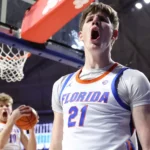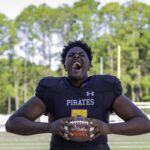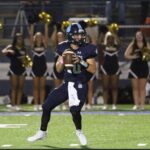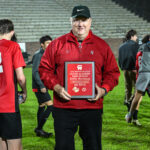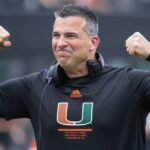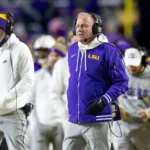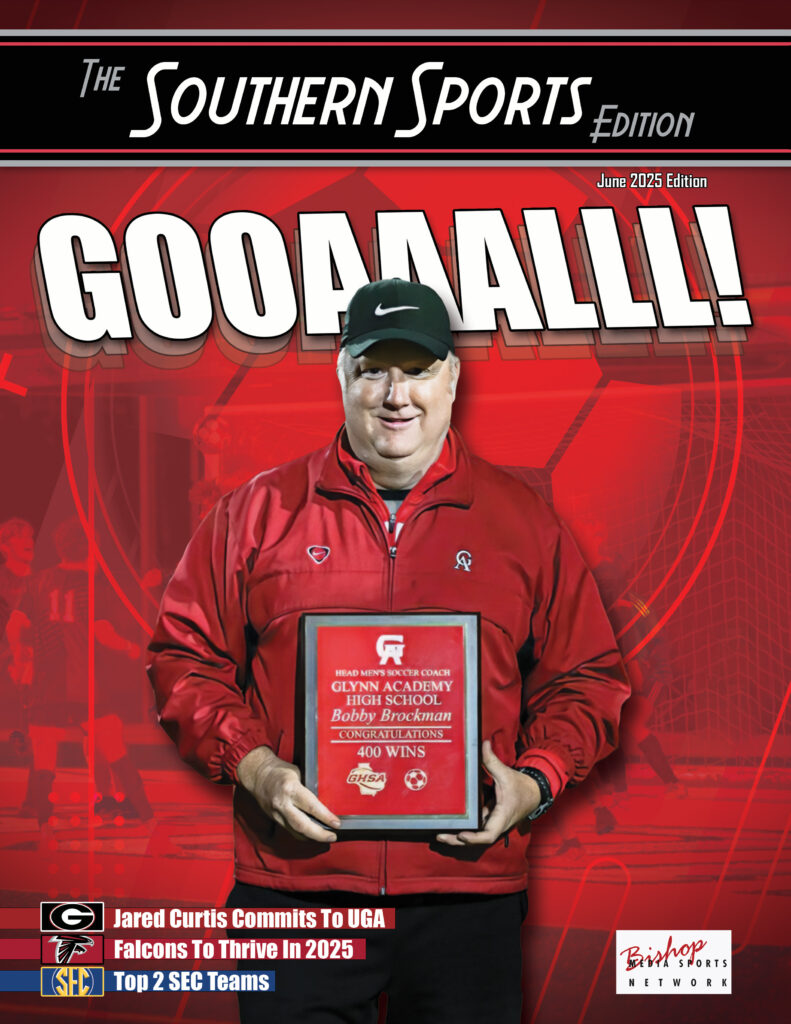I’ll Be Back
 By: Robert Craft
By: Robert Craft
TheSouthernSportsEdition.com news services
Alex Condon will return to Florida for his junior season.
The Florida men’s basketball program’s roster for the 2025-26 season, as of today, is essentially complete: with one starting roster spot available for a development-focused player.
What started out as a slow transfer portal turned into a masterclass by Florida’s newly equipped coaching staff.
It’s readily apparent the Gators have the pieces in place to make a second run for a national championship under head coach Todd Golden, mirroring his predecessor Billy Donovan. As difficult of a feat as it is to accomplish, they are once again a serious contender coming off a National Championship.
As for replacing Walter Clayton Jr., Florida brought in a mid-major transfer, Princeton’s Xaivian Lee, giving the Gators a crafty and explosive guard who excels with the ball in his hands.
Lee has an impressive first step, with the speed to blow by his defender and the court vision to attempt a high-percentage look or find the open man when the defense collapses.
While some may question his ability to succeed at a similar rate in the nation’s toughest conference, Lee consistently dominated Power Four competition when given the opportunity, and he stood out in 2024 at the G League Combine. He proved that he can play and succeed against the country’s best.
Continuing to target the backcourt, Florida keyed in on Ohio University transfer AJ Brown, who will presumably fill a role similar to Will Richard’s: a lights-out shooter from long-range who provides impressive defense and the ability to battle on the boards in the low post.
Brown is projected to begin the season as Florida’s 6th man, followed by center Micah Handlogten, giving the Gators a polished, experienced scorer in the second unit.
Although Brown may not start from the jump in Gainesville, the Gators intend to spend the summer evaluating their rotation. It’s possible Thomas Haugh returns to a bench role, with Brown sliding into the three spot for the Gators.
Only time will tell how Brown fits into UF’s rotation, though it’s in my opinion an impressive addition, one which will benefit his younger brother, Isaiah Brown, too.
Speaking of Isaiah, anyone who is underestimating the Orlando native: it would not be a surprise to see Isaiah Brown play a notably increased role during his sophomore season.
He’s an impressive outside scorer and he’s physical, yet quick enough to defend one through three although he did not display his full potential last season. The coaching staff thinks highly of Isaiah Brown, and that extra regard and attention goes a long way.
Meanwhile, Florida prepared contingency in late April. The Gators’ coaching staff recruited and acquired one of the nation’s top freshmen during 2024-25.
You know, the one who pulled out of the 2025 NBA Draft and will return to college for one more year, but not at Arkansas.
As critical as retention was, it’s the additions that may put Florida firmly back in contention for a title, and not just via the transfer.
After retaining, reconstructing, and retooling, the Gators managed the previous two months as well as any program could hope for, and expectations will undoubtedly be enormous.
Florida should be a preseason top 10, if not a top five team, in the months ahead, and it’s because the Gators are coming off their third national championship in program history AND Florida dominated this spring.
The schedule will be daunting throughout the upcoming season. The non-conference slate should be more challenging than it was during the 2024-25 campaign, and Southeastern Conference play will consistently challenge each of the league’s 16 member schools.
If the Gators stay healthy they will handle the weight of expectation. Perhaps if they keep their underdog mentality from last season, Florida will contend for a second-straight national championship following Condon’s decision to return to Florida.
A Flat(s) Legend
 By: Colin Lacy
By: Colin Lacy
TheSouthernSportsEdition.com news services
For the last three baseball seasons, I’ve had the unquestionable privilege of calling Georgia Tech Baseball games on the radio for the Georgia Tech Sports Network.
Along with that, I’ve been welcomed into the program by so many people, but especially (now) 32nd year Head Coach Danny Hall.
On March 27th, just before welcoming in Clemson in for a big ACC weekend, Coach Hall announced that 2025 would be his final season leading the Georgia Tech Baseball program and is retiring at the end of the season.
Georgia Tech has been a fixture in the College Baseball fabric for many years and much of that comes from Head Coach Danny Hall that took over the Jackets in 1994 after a six-year stint as the head coach for the Kent State Golden Flash.
Since leading the Ramblin’ Wreck, Coach Hall just locked up his 4th ACC Coach of the Year award that was announced just after Georgia Tech secured the 2025 regular season ACC Championship.
Danny Hall has come from a widely branched coaching tree that begins close to home.
Coach Hall’s dad first instilled the love of sports in him and was his head coach in high school for both baseball and football in Coolville, Ohio.
Hall would then take his talents to Miami (OH) where he played for the (then known as) Redskins (now referred to as RedHawks).
At Miami (Ohio), Hall would learn under the tutelage of legendary member of the Miami (OH) “Cradle of Coaches” Bud Middaugh. After playing for Coach Middaugh, Hall would immediately start his coaching career in 1978 as a graduate assistant under Middaugh at Miami (Ohio). “DH” graduated from Miami (Ohio) for the second time with a masters in 1979 and would make his way to Ann Arbor to be an assistant for the Michigan Wolverines under…you guessed it…Bud Middaugh. Hall spent eight years on staff for Michigan before his first opportunity to lead a program came in 1988 to lead Kent State.
There are so many accolades that you could rattle off under Coach Danny Hall’s name in his 38-year head coaching career.
He moved into the 9th all-time winningest head coach in D1 College Baseball history this year with over 1,400 career wins and is second active only to now South Carolina’s Paul Mainieri who came out of retirement this past offseason.
He has taken Georgia Tech to three appearances in the College World Series in 1994, 2002 and 2006, so the accolades speak for themselves.
That said, there’s one accolade that you won’t find on a stat sheet but is the one that means the most to the skipper. It’s the family environment and culture he has established at Georgia Tech.
Each game you can find Coach Hall’s wife, Mrs. Kara, hosting numerous alumni in the Home Plate Club that are dying to get back to their next game at Mac Nease Baseball Park and Russ Chandler Stadium.
The family of Georgia Tech Baseball is widespread from Major League Baseball former superstars of Nomar Garciaparra, Jason Varitek, or Mark Texeira, to current big-league studs like Chandler Simpson, Kristian Campbell and more.
The Tech Baseball alumni success doesn’t only translate to professional baseball as it includes names like Ben King who graduated from Georgia Tech in 2024 and is now in medical school.
Doctors, lawyers, and financial experts are found frequently coming back to visit the program and the coach that brought them to the Flats. It doesn’t stop there however, because currently, you’ll see the current staff’s family and kids throughout the facility and wanting to be part of the program now and for a long time.
So while, you can look at a Hall of Fame sheet and know that Danny Hall has had an unquestioned impact on not only Georgia Tech Baseball but College Baseball as a whole on the field, rest assured that the impact that 17 has had beyond the diamond is profound, and that’s as much of a reason why the number was retired by Georgia Tech Baseball at the end of the regular season and 17 will forever only have “Hall” on top of it on a Jacket’s Jersey, and hopefully will be worn for the last time in College Baseball’s Heaven…Omaha.
Pirates Prepping for 2025
 By: Cameron Miller
By: Cameron Miller
TheSouthernSportsEdition.com news services
High School football season for the Brunswick High Pirates is right around the corner and with the Pirates coming off a great season with a team loaded with talent, I can’t wait to see how Reigning 2024 All Region 1-AAAAA Coach of the Year Garrett Grady is leading his team into this season.
Brunswick finished up last year with 6 Offensive All-Region 1st Team selections, which were QB Grant Moore, TE Heze Kent, WR Waseem Murray, OL Chase Richardson, OL Kasiyah Charlton, and WR Jamarious Towns.
The Pirates also had 6 Defensive All-Region 1st Team selections, which were DL Lance Brown, LB Caleb Butler, LB Jeremiah Robbins, CB Sekhi Ashley, LB Kregg Richardson, CB Aviyon Addison, and J’Shawn Towns, who was the 2024 All Region 1-AAAAA Defensive Player of the Year.
The off season didn’t start off as the Pirates had expected. They are missing one big piece of their program right now, Coach Grady said “We were without our Defensive Coordinator Coach Thomas Tedder this Spring. Our thoughts & prayers are with him and his family. We are going to Coach and play at the highest level to honor him. He had a medical emergency and is still recovering.”
Although Brunswick had a few key playmakers graduate this year, they still have a loaded roster of players that are fired up to play their hearts out for Coach Tedder.
The team is also continuing to quickly develop and get better every day. When I asked Coach Grady about how the team was shaping up prior to this year’s Spring Game he told me “I thought the entire Spring Practice we got better over the 10 days we were allowed to practice. The effort was great and our coaches did a phenomenal job coaching and teaching our guys fundamentals.”
“During the Spring Game our guys competed at a high level and communicated well on both sides of the ball.” said Coach Grady following the Pirates 2025 Spring Game, which was held earlier this month.
Starting Quarterback Grant Moore who has Multiple D1 offers from Schools such as Murray State, Samford, Eastern Kentucky, did not participate this year, because he is in the final stages of coming back from a shoulder injury that happened this past baseball season.
With Moore not playing it left a lot of time for other quarterbacks Keagan Walker and Eli Overton to show off their skills and get some good reps in front of a good crowd.
The Pirates might not have had their star quarterback in the game, but they did have both of their star running backs, Josiah Gibbons who has offers from West Virginia, Tulane, East Carolina, Arkansas State, Liberty, and Kennesaw State, and Nigel Gardner who has offers from Eastern Kentucky, Arkansas State, and Eastern Carolina.
Those two have the privilege of having a wall of an offensive line led by UCF Commit Kasiyah Charlton, and Chase Richadson who has many Big D1 Offers from Georgia Southern, Kentucky, Army, Navy, West Virginia, Appalachian State, Georgia State, and many others.
Besides the depth in the run game, Moore will also have 2 monster weapons at his disposal in the passing game. Wide receiver Waseem Murray is coming off an amazing 2024 season for the Pirates where he was able to receive solid offers from Georgia Southern, Central Michigan, and Northwestern State.
The other big target Grant will have in the Passing game is 6’5 265 lb, 4 Star TE Heze Kent. Kent is going into his senior season with the Pirates and has received a total of 47 Offers to play college football.
He has his options narrowed down to the Top 5, and will be accounting his commitment between Florida, Miami, Florida State, Georgia Tech, and Texas on July 12th, 2025.
So, we’ve covered the talent all around the offensive side, but we can’t forget about stud CB Aviyon Addison, who just received his first offer from Arkansas State.
I see Addison having an amazing 2025 season and making a run for that defensive player of the year spot.
Brunswick High will scrimmage at home against the Ware County Gators. Then the season starts on the road on August 15th in Kingsland against the Camden County Wildcats and will finish their regular season at home against the South Effingham Mustangs.
Here is a look at the full Brunswick High Pirates 2025 Schedule:
8/8: vs Ware County
8/15: @ Camden County
8/22: vs Wayne County
8/29: BYE
9/5: vs Effingham
9/12: @ Evans
9/19: vs Greenbrier
9/26: @ Glynn Academy (Brunswick)
10/3: vs Bradwell
10/10: @ Statesboro
10/17: @ Lakeside
10/24: BYE
10/31: vs South Effingham
The College Diamond
 By: Robert Craft
By: Robert Craft
TheSouthernSportsEdition.com news services
64 NCAA Tournament teams will be announced next Monday, and the SEC is in position to grab up to 10 of the 16 Regional host sites and six of the eight national seeds.
Heading into conference tournaments, these seven teams have all but locked up a top eight seed, which means home-field advantage all the way through the Super Regionals. Teams are in order of RPI, not projected seed.
Georgia (1)
Auburn (2)
Vanderbilt (3)
Texas (4)
Arkansas (5)
LSU (8)
Teams on the hosting bubble.
Alabama (9)
Florida (13)
Tennessee (16)
Ole Miss (18)
Some notes on the bracket hopefuls: Alabama’s RPI is very strong, but the Crimson Tide have only two series wins against Tournament-caliber teams (Oklahoma and Georgia).
Florida went 15-15 in the SEC, but six of those wins came against South Carolina and Missouri. On a positive note, the Gators won series vs. Texas (on the road) and Arkansas.
Tennessee went 16-14 in the SEC and lost their last five series. They have one of the weakest non-conference schedules (216).Tennessee has joined a long list of defending national champions that have struggled, relatively speaking, the following season.
Only one of the last 10 national champs, 2017 Florida, was a top eight seed the following season (the Gators were No. 1 overall). Four of the other nine were hosts but not top eight seeds, and four failed to make the tournament.
Florida miraculously ended its 2025 regular season .500 in Southeastern Conference play after opening 1-11 against league squads, capping off the turnaround with a series victory over Alabama at home on Saturday [W 7-6; L 6-9; W 9-3] and securing the No. 10 seed in the upcoming SEC Tournament.
Vanderbilt, the 2019 champs, did not have an opportunity to defend its title due to the pandemic. The Commodores were the No. 4 overall seed in 2021.
Vanderbilt enters the postseason as one of the hottest teams in the country. The Commodores won their final five SEC games — many in dramatic fashion — to finish 39-16 overall and 19-11 in the SEC.
Vanderbilt swept Kentucky in Nashville over the weekend, winning the first two games on back-to-back walk-off home runs. Outfielder Braden Holcomb, down to his final strike with two outs, hit a three-run blast to give Vanderbilt an 8-7 win.
Then, after Kentucky rallied from down 7-5 at the top of the ninth to take an 8-7 lead, shortstop Jonathan Vastine hit a two-run home run with one out to walk off the Cats once again.
These heroics were nothing new for Vanderbilt. Two weeks earlier, the Dores rallied from down 7-2 in the eighth to beat Alabama with a two-run Holcomb homer with two outs in the bottom of the ninth.
For Kentucky, it was a painful ending to a regular season that featured eight SEC losses by one run and another three by two runs.
At 29-23 overall and 13-17 in the SEC with an RPI of 36, the Cats head to the SEC Tournament on the NCAA Tournament bubble. They play Oklahoma on Tuesday.
The SEC will be well represented and this year‘s College Baseball World Series tournament. It’s just a matter of who will host and who will travel.
I predict four SEC teams will make it to Omaha and one will be crowned national champion.
Air Wildcats
 By: Michael Spiers
By: Michael Spiers
TheSouthernSportsEdition.com news services
This fall’s football season will be the second for head coach Travis Roland with the Camden County Wildcats. And what a difference a year makes.
Both Roland and Offensive Coordinator Grant Alford arrived in Kingsland following the 2023 season. That season saw the Wildcats make it to the final four of the state playoffs and then the retirement of Hall of Fame coach, Jeff Herron.
The cupboard was not bare by any stretch of the imagination upon the new coaches’ arrival, but Roland and Alford brought with them a completely different style of football.
The Wildcats have been evolving into more of a passing offense as compared to Herron’s vaunted Wing-T, smashmouth style of football.
Earlier this month, at Chris Gillman Stadium in Kingsland, the Wildcats put on their annual Blue/White Spring Extravaganza. It was definitely an offensive showcase where the football was put into the air with regularity.
The format of the contest was basically a scripted scrimmage with series featuring the Attack (first team) offense against the Attack defense from different distances and situations.
It started with drives from the offense’s own 30-yard line for the opportunity to pick up multiple first downs, followed by series from the defense’s 35-yard line, and then some goal-line work from the 10-yard line.
These same scenarios were played out with the Bite (second team) offense and defense, and the Claw (third team) offense and defense.
The most exciting part of the evening was watching two players battle for the QB1 spot.
One contender for the position is rising senior Parks Riendeau, who has been the unquestioned leader of the team and has been the starting quarterback for the past two seasons.
The other is rising junior Will Jackson, who transferred to Camden from a school in central Florida back in December. At 6’4” and 205lbs, Jackson has prototypical size for the QB position and he already has multiple offers from Division 1 schools, including South Carolina, Arkansas and Virginia Tech.
Rieandeau displayed complete control of the offense, his group scoring touchdowns on each of his first two possessions.
One a scoring pass to rising senior receiver Jeremiah Bass, and the other a touchdown toss rising junior and all-around star athlete, Sean Green.
Riendeau’s poise and decision-making skills will make him tough to beat. He knew exactly where to go with the ball each opportunity, and utilized his two senior running backs, Julien Daily and Antwan Williams, with confidence.
Jackson also got his opportunity to operate the Attack offense, and if he was a little tentative at first, his athletic ability was on full display.
Jackson has a similar ability that his NFL namesake, Lamar Jackson, possesses. With what appears to be no more than a tiny flick of the wrist, he is able to launch a football 40 yards down the field with accuracy and precision.
He also threw multiple touchdown passes to emerging star senior receiver, Tyler Mapel.
Whichever player is given the keys to this Wildcat Offense; he could be in for a record-breaking year.
Camden County kicks the fall season by hosting the Brunswick Pirates in Kingsland on August 15th and won’t hit the road until a trip to Richmond Hill in week 8, on October 3rd.
The full Camden County football schedule for 2025 is:
Friday, Aug. 8: Benedictine (scrimmage), 7:30 p.m.
Friday, Aug. 15: Brunswick, 7:30 p.m.
Friday, Aug. 22: East Lake, Fla., 7:30 p.m.
Friday, Aug. 29: West Broward, Fla., 7:30 p.m.
Friday, Sept. 5: Ribault, Fla., 7:30 p.m.
BYE
Friday, Sept. 19: Royal Palm Beach, Fla., 7:30 p.m. (Homecoming)
Friday, Sept. 26: Valdosta, 7:30 p.m.
Friday, Oct. 3: at Richmond Hill, 7:30 p.m.
Friday, Oct. 10: Lowndes, 7:30 p.m.
BYE
Friday, Oct. 24: at Colquitt, 7:30 p.m.
Friday, Oct. 31: at Tift, 7:30 p.m.
Glynn Goals
 By: Joe Delaney
By: Joe Delaney
TheSouthernSportsEdition.com news services
I had a chance to sit down recently with one of the greatest high school coaches in the state and southeast.
Yes, I’m talking about our own Bobby Brockman from Glynn Academy.
We had a great conversation the other day and could have talked for hours. Brockman and I go way back as both my sons went to Glynn and Knox played for Bobby some 15+ years ago.
Growing up every kid wanted to go to the soccer camps on Jekyll. It was amazing on those Saturday mornings. Bobby Brockman was a major player in all of this.
I was fortunate to live in Clearwater, FL for 3 years in my late 20’s and became enamored with pro soccer, as this was the prime time of the Tampa Bay Rowdies.
Watching pros like Rodney Marsh and Steve Wegerle from the Rowdies take on Giorgio Chinaglia and the New York Cosmos in front of 60k fans was a great way to get indoctrinated into the game.
Years later I was fortunate enough to coach youth soccer on Jekyll and our 3 v 3 team was you guessed it………The Rowdies.
We had a ball and finished 7th in the 3 v 3 nationals in Disney. I don’t think I’ve ever seen 11 and 12 year old kids have so much fun. Well, seeing as though the Rowdies had something going, the next year the Rowdies coach was Bobby Brockman! We laughed and laughed about those good times.
Brockman and I grew to be good friends over the next few years and I watched the guy accomplish great things on the southside of Brunswick.
How is a 462-95-22 record over 31 years? Well, that’s a start but it may not be Bobby’s true legacy.
Bobby Brockman didn’t coach games, he coached players. And that was his greatness. Go find somebody who played for him. Ask them about Bobby. They will all tell you the same things. Simply the best. Over 500 kids and they all love the guy.
He always had his teams ready to play. A worker, a mentor, and a leader. Let’s look at some of the good times and what Coach Brockman had to say.
Glynn had many good players who Brockman brought up through the Jekyll league.
The best? Bobby mentioned the following and said, “I know I’m gonna miss some but here I go.”
Let’s start with the Craven boys. Enough said. Ritchie and Andy had it all. How about Lee Swafford, David Blackshear, Matthew Lee, Johnny Melcher and Connor Behrend? All great players for the Red and White.
Brockman also mentioned the families that were entwined with the program over the years. Names like the Fendigs, Cravens, Plotners, Swaffords and Bulataos. It truly was more than a team. It was a family that went on for 31 years.
Glynn flourished under Brockman. Try 17 region titles, 9 elite 8 appearances, and 3 Final Fours in 31 years. Add in 15 Region Coach of the Years. So, I had to ask Brockman who were his favorite teams and he said every one of them.
The best teams? Coach Brockman mentioned the 2002 final four team and the 2011 final four squad.
Last but not least was Glynn’s Final Four team from last year.
Favorite wins? He mentioned Shiloh in 2002, when we went to Atlanta and took out a good Atlanta squad 4-0.
More recently, Richmond Hill for the 400th win and last year’s team taking out St Pius and Lassiter, two very good Atlanta Schools.
Brockman was particularly happy with the Lassiter win. Seems as though Lassiter came down to Brunswick with a bad attitude and talked all through the game how Glynn wasn’t very good.
I can’t say what they were really saying but you get the drift. Well Lassiter, the two-time defending state champs, had a long bus ride back to Atlanta losing 3-2. Don’t mess with Coach Bobby!
So now the 2025 season is in the history books. A tough second round loss to Veterans 1-0 ended it.
And all good things must come to an end. Brockman has coached his last game for Glynn.
After 31 years, he is retiring and moving to the Ocala area. Family issues necessitate the move but he will be back often with camps and visits.
Coach Brockman will go down as one of if not the greatest soccer coach in South Georgia.
He built the Glynn Program and through the liaison with Jekyll had a profound impact on soccer growth in south Georgia.
But his lasting impact is that 31-year-old family he built. Safe travels my friend and God Bless.
Even Ground
 By: Cameron Miller
By: Cameron Miller
TheSouthernSportsEdition.com news services
Let’s not sugarcoat it, the Atlanta Braves began the 2025 about as poorly as you could imagine, which put them in trouble. Deep trouble.
The Braves were a team that came into the season with real championship aspirations and a roster that’s loaded with All-Star talent. The first half of this season so far was really nothing short of a flat out failure.
They’ve been dealing with major injuries such as a pair of their young Superstars, Ronald Acuna Jr and Spencer Strider, being out of the lineup for them.
The injuries are one excuse, but at the end of the day you’ve got to step up with “next man up” mentality and that’s something they just couldn’t do at the beginning of the season. They had many of us wondering if this was really the same Braves team that once ruled the NL East.
So yes, reaching a .500 win percentage may not seem like much, because at this point it doesn’t even earn you a playoff spot, But make no mistake this milestone really does matter.
It marks a turning point in a season that, not too long ago, really looked like it might spiral into something we would all want to forget.
But here’s the thing about baseball, it gives you time. Time to figure it all out. Time to get healthy and get motivated.
And, over the past few weeks, the Braves finally have shown signs of life. They managed to claw their way back to .500 (21 wins & 21 losses) without the help of Ronald Acuna Jr or Spencer Strider and in doing so, they’ve reminded everyone around the league that they’re not going down without a fight.
The .500 mark isn’t about mediocrity; it’s about resilience and determination.
Eli White has been making a good start as a placeholder for Ronald Acuna Jr in right field, but Acuna is scheduled to rejoin the team for action on June 1st, so when he does make his way back in the starting lineup, the Braves will have another solid option in the field or at the plate if needed.
Spencer Strider on the other hand has been dealing with all different types of injuries; he has been dealing with a right elbow sprain since last season and right now it’s a right hamstring sprain he’s working to come back from.
Still, let’s not get too romantic about a .500 team. This roster was built to contend, not just merely survive.
The Braves aren’t in first place; they aren’t even leading the Wild Card race. But they’re alive and just a few weeks ago, that felt like a long shot. They picked up some steam just in time to try and give themselves a real chance to make a push in the NL East.
Reaching .500 isn’t a reason to celebrate, but it is a call to action. It’s a sign that the Braves have turned the tide just enough to make the rest of the season meaningful and enjoyable. And in a year where they were getting close to playing themselves out of relevance, that’s a victory worth acknowledging.
If they keep this momentum going, we’ll look back at this week not as a meaningless statistical checkpoint, but as the moment the 2025 Braves started to matter again.
Falcons to Thrive in 2025?
 By: Michael Spiers
By: Michael Spiers
TheSouthernSportsEdition.com news services
The 2025 season is shaping up to be a turning point for the Atlanta Falcons.
There’s a new energy around the team, thanks to a mix of fresh talent, major roster shakeups, and a schedule full of primetime matchups. One name already making headlines is rookie linebacker Jalon Walker. He has the makings of a superstar.
Walker, a former Georgia Bulldog and Butkus Award winner, was a first-round pick this year and already has big expectations on his shoulders.
He made a name for himself in Athens with a monster 2024 season, and now he’s bringing that fire to the NFL, hoping to spark a new era for Atlanta’s defense.
And speaking of Bulldogs, one of the biggest games on the Falcons’ upcoming schedule will have a full-circle moment for Georgia fans.
The Falcons will face the Los Angeles Rams on Monday Night Football, and that means Walker will go head-to-head with Rams quarterback, and fellow Bulldog legend, Matthew Stafford.
Stafford was the No. 1 overall pick back in 2009 and is still one of the most respected QBs in the league. It’ll be the first time these two Bulldogs share the field, and it’s happening right back in Georgia.
But that’s just one of several big-time games on Atlanta’s radar. The Falcons are set to appear in five primetime games this season, which shows the league sees them as a team worth watching.
They’ll host the Bills and Rams on Monday Night Football, hit the road to take on the Vikings and 49ers on Sunday Night Football, and battle the Bucs on Thursday Night Football.
Oh, and don’t forget, the Birds are heading to Berlin in Week 10 to play the Colts in the NFL’s first-ever game in the German capital.
Last year, the Falcons went 3-2 under the lights, picking up wins against the Eagles, Raiders, and Bucs. They handled the spotlight relatively well last season, and they’ll get plenty more chances to show that they belong in primetime this year.
Of course, the team isn’t without its challenges. Grady Jarrett, a longtime anchor on the defensive line, is no longer with the team and his absence leaves some big shoes to fill.
That’s where Walker, fellow rookie James Pearce, and hopefully a few veteran additions come into play. There’s even talk that Atlanta could bring in someone like Jadeveon Clowney to help solidify the front seven.
And then there’s the quarterback situation. It appears Michael Penix Jr. is firmly entrenched as the starter, but it’s going to be fascinating to see if the Falcons hold on to Kirk Cousins, who would potentially be the highest paid backup quarterback in league history if some other team doesn’t try to pry him away.
Would Atlanta consider dealing him to a conference rival after the news that Derek Carr is retiring and the New Orleans Saints are left with only rookie Tyler Shough and the unproven Spencer Rattler?
Still, there’s plenty to be excited about. Drake London is blossoming into a star, the defense is getting younger and faster, and the schedule is packed with marquee matchups. It won’t be easy, but the Falcons are clearly aiming to build something sustainable.
The success of the Falcons will depend on how the pieces come together, but with so many eyes on Atlanta in 2025, fans won’t have to wait long to find out if this team is ready to “Rise Up”, or if they struggle to fly from the nest.
Either way, it should be a wild ride.
Storm Brewing?
 By: Robert Craft
By: Robert Craft
TheSouthernSportsEdition.com news services
The Hurricanes won 10 games for only the second time in 20 years.
Their explosive offense led the nation in scoring (43.9 points) and produced the No. 1 pick in the NFL Draft. Still, 2024 still felt like a disappointment.
Miami’s defense was sabotage in action finishing 69th in scoring (25.3 points) and allowing 61 plays of 20-plus yards (94th nationally).
Their defensive performance was why Miami missed the College Football Playoff with a 42-38 loss at Syracuse in the final weekend of the regular season to knock them out of the conference championship.
Often praised for his recruiting, coach Mario Cristobal elevated Miami, a team who signed top 10 recruiting classes in 2023 and 2024. The Hurricanes don’t play defense, which falls on coaching.
Cristobal hired Minnesota defensive coordinator Corey Hetherman, who led a top 10 scoring defense (16.9 points) that finished 12th in yards per play allowed (4.76) in 2024. Miami gave up 30+ points in six of its 13 games last season. Meanwhile, Iowa was the only team that scored 30 points on Minnesota last year.
Miami made a concerted effort to retool its secondary by bringing in six transfers, headlined by Xavier Lucas from Wisconsin and, most recently, Houston/Auburn transfer Keionte Scott.
Miami has holes to fill on offense, too. In addition to Cam Ward, the Hurricanes lost their top four wideouts (Xavier Restrepo, Jacolby George, Isaiah Horton and Sam Brown) and tight end Elijah Arroyo.
Most notably, there was the high-profile addition of Carson Beck, Georgia’s top quarterback. Praise be the transfer portal!
Miami is very fortunate to have replaced Ward immediately and keep their momentum on offense.
In addition, Miami landed several receiver transfers: CJ Daniels (LSU/Liberty), Keelan Marion (BYU) and Tony Johnson (Cincinnati).
Beck didn’t throw in the spring while recovering from an elbow injury he suffered in the SEC Championship Game.
He’ll have to develop chemistry with a new set of receivers and acclimate to a new offense quickly — and get more help from the revamped defense than Ward did — for Miami to win the ACC for the first time and earn a Playoff spot.
The Canes NIL presence has always been well known. LifeWallet CEO John Ruiz made the Hurricanes an immediate player in the name, image, and likeness space by doling out millions to bring talent to South Florida.
While his involvement with the program has since faded given some recent financial issues, the school’s attitude towards utilizing NIL to build its roster hasn’t budged.
Miami’s NIL estimated spin for 2025 it’s between $20-$25 million.
Miami’s investment paid off on the recruiting trail where they were able to convince top prospects to spurn notable programs in order to sign with The U.
The Canes are just below Texas and Georgia for the most estimated NIL spend in the country.
Will it translate into wins on Saturday, an ACC championship and a college football playoff slot?
Top Portal Classes
 By: Kenneth Harrison
By: Kenneth Harrison
TheSouthernSportsEdition.com news services
The college football spring transfer portal window closed April 25th. Let’s take a look at the top transfer portal recruiting classes going into the summer.
#1 LSU: The Tigers are bringing in 18 players. They have 12 four-stars and 5 three-star players.
Some of the standout players are: S Tamarcus Cooley (NC State), DL Bernard Gooden (USF), S A.J. Haulcy (Houston), Edge Patrick Payton (Florida State), TE Donovan Green (Texas A&M), DL Sydir Mitchell (Texas), CB Mansoor Delane (Virginia Tech), Jack Pyburn (Florida), IOL Braelin Moore (Virginia Tech), WR Destyn Hill (Florida State), WR Nic Anderson (Oklahoma), WR Barion Brown (Kentucky), IOL Josh Thompson (Northwestern) and Edge Jimari Butler (Nebraska).
I expect LSU to be a top 10 team in the preseason poll.
#3 Miami: The Hurricanes have 19 commits. Nine of them are four-stars and 9 are three-stars.
The biggest star is QB Carson Beck (Georgia). He’s hoping to follow in Cam Ward’s footsteps because he transferred in from Washington State the year before. He was the top pick in the 2025 NFL draft.
Some of the other players are: CB Keionte Scott (Houston), S Jakobe Thomas (Tennessee), LB Mohamed Toure (Rutgers), LB Kamal Bonner (NC State), WR Keelan Marion (BYU), WR Tony Johnson (Cincinnati), TE Alex Bauman (Tulane), IOL James Brockermeyer (TCU), CB Xavier Lucas (Wisconsin), CB Charles Brantley (Michigan State), TE Jack Nickel (UAB), S Zechariah Poyser (Jacksonville State), WR CJ Daniels (LSU) and Ethan O’Connor.
The defense was the Achilles’ heel last season so they added plenty of talent on that side of the ball. I think they will start the season just outside the top 10.
#4 Ole Miss: The Rebels are adding 29 transfer players, making them one of the deepest classes. They have 10 four-stars and 19 three-stars.
They include: QB Maealiuaki Smith (Oklahoma State), OT Terez Davis (Maryland), CB Tavoy Feagin (Clemson), WR Harrison Wallace III (Penn State), WR Traylon Ray (West Virginia), OT Percy Lewis (Auburn), S Kapena Gushiken (Washington State), WR Deuce Alexander (Wake Forest) and IOL Delano Townsend (UAB).
They lost quarterback Jaxson Dart who was a first round pick in the NFL draft. They have enough talent to start the season in the top 20.
#6 Florida State: FSU showed us how badly building a team from the transfer portal can go last year.
They imploded and went 2-10 after being ranked in the top 10 in the preseason. Let’s see if things will be better in 2025. Out of their 23 commits they have 8 four-stars and 15 three-stars.
Some of them are: RB Gavin Sawchuk (Oklahoma), OT Josh Raymond (Vanderbilt), CB Jeremiah Wilson (Houston), S Jarvis Boatwright Jr. (USC), WR Squirrel White (Tennessee), DL Jayson Jenkins (Tennessee) and OT Micah Pettus (Ole Miss).
We will see if the Seminoles can bounce back.
#8 Auburn: The Tigers were 5-7 last season and only won two conference games. They have 19 commits with 6 four-stars and 12 three-stars.
This includes: LB Caleb Wheatland (Maryland), S Taye Seymore (Georgia Tech), TE Preston Howard (Maryland), OT Mason Murphy (USC), CB Raion Strader (Miami OH), WR Eric Singleton Jr. (Georgia Tech), OT Xavier Chaplin (Virginia Tech) and QB Jackson Arnold (Oklahoma).
I think they can start the season as a Top 25 team.
